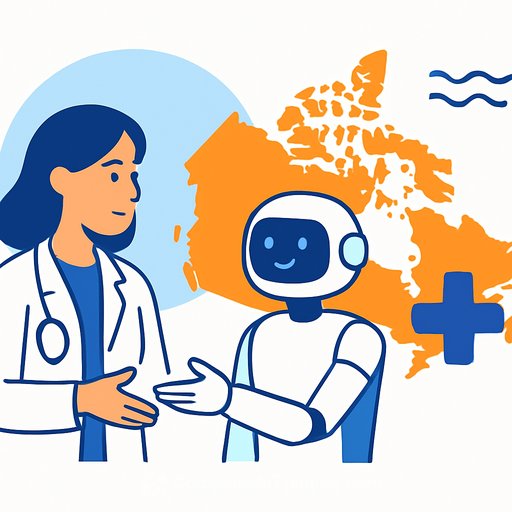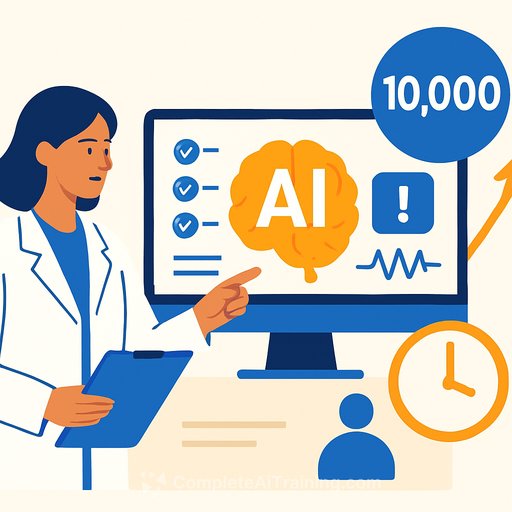AI Could Save Canada's Health-Care System
Canada is facing a simple but brutal equation: more older, complex patients are arriving while the clinical workforce shrinks. One in five Canadians is a senior today; within a decade, it will be nearly one in four. The result is care delays, burnout, and closures that patients feel every day.
New medical schools help, but they won't fix the math. We need tools that free up clinician time, route patients faster, and catch risk earlier. AI can do that-safely, measurably, and at scale.
The pressure points you already know
- 6.5 million Canadians lack a family doctor; ERs in multiple provinces have closed when safe staffing wasn't possible.
- Burnout is surging. Over half of physicians are considering reducing hours, and Canada lost 3 percent of family doctors in one year.
- Documentation and fact-finding consume the majority of visit time, shrinking space for clinical judgment and patient connection.
Where AI is already delivering
- In Toronto, risk models flag patients who need more support; one site reported a >20 percent drop in unplanned mortality after deployment.
- Quebec ICUs use AI to spot sepsis risk earlier, enabling faster intervention.
- Intake and ambient tools prebuild notes so clinicians spend minutes listening and explaining, not typing.
- Sweden: pairing AI with radiologists in breast screening kept detection rates while cutting workload by about half.
- Japan: FDA-style approved tools help detect strokes and aneurysms earlier.
- England: AI-powered smart triage reduced appointment waits by 73 percent in an NHS evaluation (NHS overview).
Why this matters for Canada
Canada has the research engine to lead. The Vector Institute advances world-class AI, and the Pan-Canadian AI for Health Strategy has set an ethical foundation (Vector Institute). McKinsey estimates scaling AI could trim up to 8 percent of health spending annually-roughly $26B on a $330B budget-without hurting outcomes. That's capital we can redirect to reopen ERs, modernize infrastructure, and hire staff.
Deploy these solutions first
- AI intake and ambient documentation: Collect structured history, summarize prior records, and auto-draft notes and orders for clinician sign-off in primary care, ED, and outpatient clinics.
- Smart triage and navigation: Direct patients to virtual, clinic, or urgent care based on risk; escalate complex cases instantly.
- Early-warning and deterioration alerts: Sepsis, stroke, and ICU risk models with clear thresholds and response protocols.
- Radiology assist and worklist prioritization: Prioritize suspicious studies and automate prelims where appropriate.
- Capacity, bed flow, and staffing forecasts: Predict surges, optimize schedules, and reduce hallway care and ALC days.
- Virtual follow-up automation: Personalized discharge instructions, remote monitoring flags, and auto-reminders to cut readmissions.
Clinical guardrails that build trust
- Human in the loop: AI drafts; clinicians decide. Every recommendation remains reviewable and overrideable.
- Validation and monitoring: Pre-go-live testing, bias checks across demographics, and live performance auditing with drift alerts.
- Privacy and security by design: PHIPA/PIPEDA compliance, de-identification where possible, encryption, clear data residency.
- Plain-language consent: Patients know where AI is used, what it does, and how it helps their care.
Procurement and policy to break the "pilot trap"
- Prefer Canadian-built tools that meet standards: Make "Canadian first" the default when safety and outcomes are equivalent.
- National model registry: Publish intended use, validation results, monitoring outcomes, and incident reports.
- Standards and interoperability: FHIR, SNOMED CT, and open APIs embedded in RFPs; no lock-in.
- Outcomes-based purchasing: Tie payment to wait-time cuts, documentation time saved, and safety metrics.
- Fund change management: Budget for training, workflow redesign, and clinical champions-not just licenses.
- Reimbursement clarity: Codes for AI-augmented visits and virtual care that reflect real clinician work.
- Pan-Canadian evaluation network: Shared methods, rapid trials, and cross-provincial scaling for proven tools.
How to measure impact in 12-24 months
- Access: Door-to-doc time in ED, days to primary care, and specialist queue length.
- Workforce: Documentation time per visit, after-hours charting, provider retention and sick leave.
- Quality and safety: Unplanned mortality, sepsis recognition time, readmissions, diagnostic turnaround.
- Financial: Cost per encounter, avoided overtime/agency spend, bed-day utilization.
- Patient experience: Net promoter score, abandonment rates, complaints linked to waits and communication.
What this looks like on the ground
A patient starts with an AI intake that captures a clean history and flags red-flags before the visit. The clinician reviews a concise summary, focuses on exam and decisions, and signs a ready-to-file note. If risk rises-sepsis, stroke, mental health crisis-the system escalates instantly and routes to the right team.
Radiology moves faster with prioritized worklists. Bed flow is predicted hours ahead. Discharges include automated check-ins that catch problems before they become readmissions. Staff finish shifts with charts closed-and energy left.
Digital sovereignty matters
If Canada acts, we keep control of our standards, our data, and our budgets while lifting outcomes. If we wait, foreign tools will fill the gap on their terms. The opportunity is to scale proven AI responsibly, at home, and relieve a system that is out of room and time.
Next step: upskill your teams
Front-line success improves when clinicians and managers know how to evaluate and apply AI safely. For role-based learning paths, see AI courses by job (Complete AI Training).
The path forward is clear: deploy what works, measure relentlessly, protect patients and providers, and scale nationally. This isn't about shortcuts. It's about giving Canadians timely care-and giving clinicians a system that supports them back.
Your membership also unlocks:






